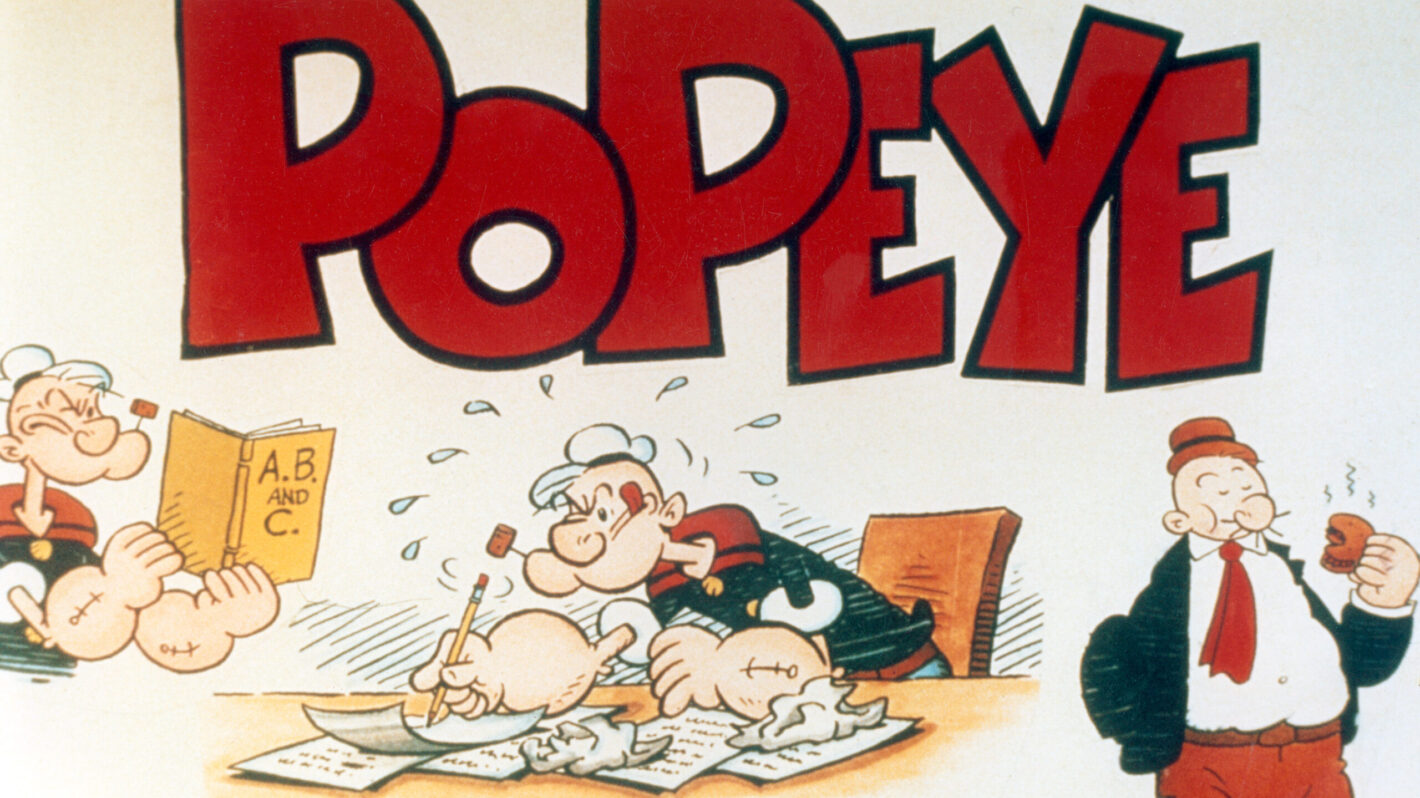History of the Infamous 1960’s ‘Popeye’ TV Cartoon Series
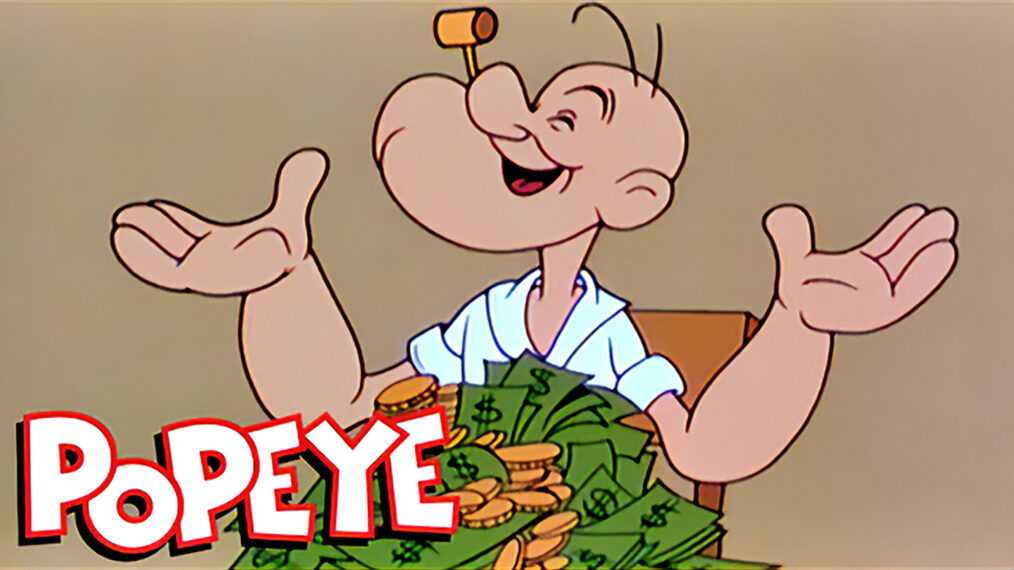
When a book is written on a film or television series, the author of the publication hopes it will entice the reader to review the subject matter with a more enlightened view. In 2022, my book, Popeye: The 1960’s TV Cartoons, was published by BearManor Media. The reviews have been generally good, but usually include this comment; “Fred has watched them all so that you won’t have to (Randall Cyrenne, Animated Views)” or “I’m so happy to have this. I’d rather read about these cartoons then to ever have to watch them again. Fred has rewatched them all so I (or any of you) never have to (Jerry Beck, Cartoon Research).”
Why is this Popeye series of 220 color cartoon episodes often viewed in such a negative light?
For one, it stars Popeye the Sailor. The beloved character initially made his debut on January 17, 1929, in E.C. Segar’s Thimble Theatre comic strip. Despite all of Popeye’s success in the print medium, his fame skyrocketed when Fleischer Studios used his image in a series of black & white theatrical cartoons. These became both a critical and financial success for their distributor, Paramount Pictures. Fleischer Studios began the series in 1933 and Famous Studios resumed control in 1942. By late 1943, the sailor’s films were being produced in full color. When the theatrical series ended in 1957, two hundred and thirty- four cartoons had been completed. Popeye still holds the record for starring in the longest running animated short series originally seen in theaters.
In September of 1956, these same cartoons debuted on the small screen and were a smashing success! All over the country, adults dressed as captains, cowboys and sailors hosted their own programs airing Popeye’s antics.

Randy Milholland – Thimble Theatre‘s current Sunday cartoonist
In 1959, King Features Syndicate, who owned the rights to the characters but not to the theatrical cartoons, wanted to cash in on this Popeye mania. They decided to crank out new Popeye episodes, which they would syndicate. Al Brodax became executive producer of these color cartoons. His goal was to have two hundred and ten episodes (eventually totaling two hundred and twenty) released as quickly as possible. King Features Syndicate wanted to strike while the iron was hot! Who knew how long this tremendous interest in Popeye would last?
Unlike the theatrical films, several characters from the Thimble Theatre comic strip were animated for the first time. These included: The Sea Hag and her loyal vulture, Rough House, King Blozo, Toar and Alice the Goon. Old favorites, Olive Oyl, J. Wellington Wimpy, Swee’pea, Poopdeck Pappy and Eugene the Jeep also appeared.
Also in the cast was a fat, bearded bully named Brutus. Despite being billed as a newcomer he resembled and sounded a lot like Popeye’s enemy in the theatrical cartoons, Bluto. King Features Syndicate was mistakenly informed by Paramount Pictures that Bluto was created for animation by Fleischer Studios. However, the brute first appeared in Segar’s strip in 1932. King Features Syndicate forgot Bluto’s newspaper roots and Brodax decided to rename him Brutus after Julius Caesar’s assassin. It should be noted: Jackson Beck, who provided Bluto’s voice in the color theatrical Popeye films, voiced Brutus. Jack Mercer and Mae Questel, both of whom provided voice work in the sailor’s earlier screen appearances, also returned for these new cartoons.
When the new Popeyes hit the airwaves, like the earlier cartoons, they were a smashing success. Television stations either mixed the episodes with the theatrical films or as a separate series. By September 21, 1960, 71 stations were airing the cartoons. The year 1964 saw the number rise to 137. This same year, it was reported King Features Syndicate had grossed $6,000,000 in sales. They were also airing in Canada, Australia, the Philippines, Japan and Brazil.

©King Features Syndicate and from The Personal Collection of Fred Grandinetti
The series was originally offered to stations in black and white, as color programming had not yet become the norm. The July 26, 1965, edition of Broadcasting stated: “King Features reported last week more than 1.5 million in billings in renewals of its Popeye cartoons, now in 138 markets. According to Al Brodax, director of TV, 26 of the stations that originally bought the cartoons in black and white have switched to color prints, noting that the cartoons [are] also reaching new audiences since they were first offered to stations five years ago.”
The success of this version of the animated Popeye also spawned a live act utilizing the sailor man and Brutus. The Logan Daily News’ June 6, 1963 edition noted: “Next week over at the Palisades Amusement Park in Jersey, actor Herb Messinger — who makes his living impersonating the old spinach kid — will do a series of public series of sit-ups, pull-ups, etc., as a climax to King Features Syndicate’s “Popeye’s Physical Fitness Campaign.” While Messinger portrayed Popeye, George Quinn was the bearded Brutus. The pair debuted at the 1962 opening of Freedom Land in New York City, where they stayed for five weeks. Their stops also included appearances at Kennywood Park in Pittsburgh and the Delaware State Fair.
Popeye production studios
Unfortunately, the quickness in production of these Popeye cartoons led to a lot of mistakes in the animation. The concept of producing animation for the small screen was still a relatively new field. Many animators, who were used to working on films for theaters, had difficulty adapting to less time and smaller budgets. The Popeye series was worked on by six different studios, each having their own strengths and weaknesses.
Larry Harmon Productions
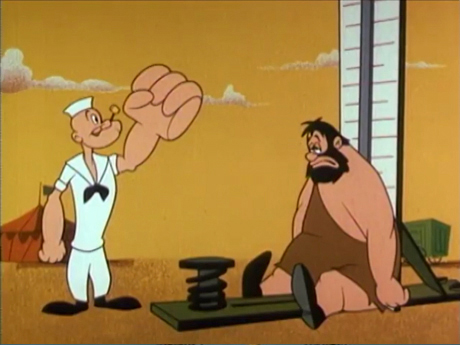
©King Features Syndicate and from The Personal Collection of Fred Grandinetti
The character designs were rather simplistic and stories featured primarily Popeye, Olive Oyl and Brutus. They were fast moving, and some of the plots were imaginative, but the animation was lazy in its execution. Harmon did slightly better with his best-known cartoon series, Bozo the Clown. While working on Popeye, Harmon’s studio also contributed episodes to UPA’s Mr. Magoo and Dick Tracy programs.
William Snyder/Gene Deitch

©King Features Syndicate and from The Personal Collection of Fred Grandinetti
These cartoons, produced outside of the United States, also featured simplistic character designs which, sometimes, got in the way of the witty stories. However, many were highlighted by lighthearted and eerie musical scores.
John Halas & Joy Batchelor
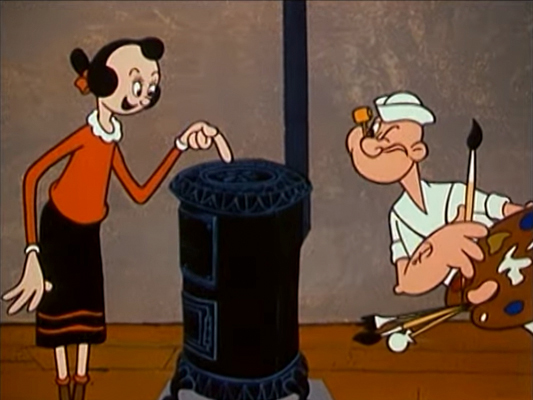
©King Features Syndicate and from The Personal Collection of Fred Grandinetti
This duo of animators were credited on the cartoons from the Snyder/Deitch output. Their episodes have fluid movement and entertaining stories.
Gerald Ray

©King Features Syndicate and from The Personal Collection of Fred Grandinetti
He was best known for producing the adventures of King Leonardo and his Short Subjects, and sadly produced less than a dozen Popeyes. Ray’s cartoons captured the quirkiness of the characters and moved along at a fast clip. Each one ended with with lyrics relating to the story, sung to Popeye’s theme music.
Paramount Cartoon Studios
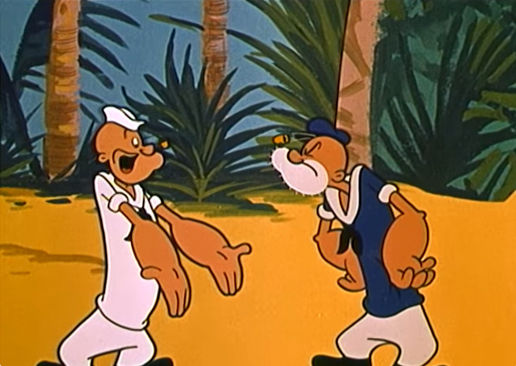
©King Features Syndicate and from The Personal Collection of Fred Grandinetti
This studio was previously known as Famous Studios and used much of the same personnel that worked on Popeye’s theatrical cartoons. The animation was well above most of the TV fare being produced during this same period. They also utilized composer Winston Sharples’ musical scores, heard in Popeye’s color output for the movie screen. Paramount’s films were more all-out adventure stories and often used E.C. Segar’s Thimble Theatre stories as source material. Jack Mercer, the voice of both Popeye and Wimpy, also contributed scripts. In addition to performing voice work, Mercer was also a writer and artist.
Jack Kinney
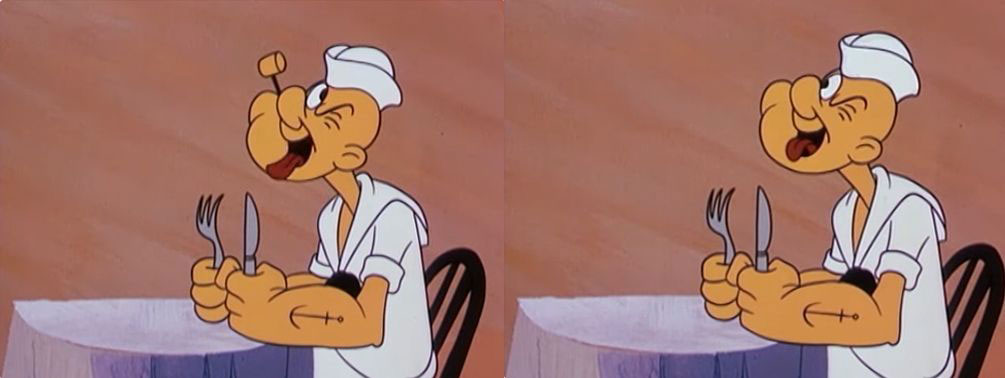
©King Features Syndicate and from The Personal Collection of Fred Grandinetti
Kinney’s studio produced the bulk of the Popeyes. The stories were often witty, with jokes a little over the heads of the kiddos. The quality of animation in a Kinney episode depended upon who was credited as the animation director. As previously noted, some had more experience with limited animation than others. As Hal Erickson stated in his book, Television Cartoon Shows, An Illustrated Encyclopedia 1949 through 1993: “The most appalling aspect of the Kinney Popeyes was the series’ sloppiness. Even allowing [for] the fact that Kinney was denied the luxuries of time, budget and large staff, many of his Popeyes were so clumsily made as to be unwatchable. Alas, the very abundance of the Kinney Popeyes reflected badly on the rest of the series. Viewers tended to forget the good moments and recall only the bad.”
Truthfully, at the age of five, I didn’t notice Popeye’s pipe appearing and disappearing mid-sentence. To me, and millions of other children, they were just more Popeye cartoons to enjoy. Not only did this series of cartoons gross millions of dollars for King Features Syndicate, but they also led to more toys, games and novelties.
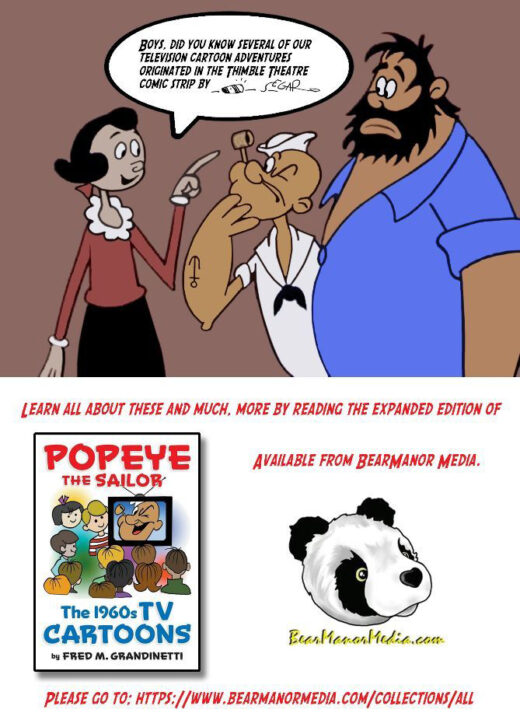
In 2024, based on the reviews of my book, I decided to expand my publication, spotlighting more of the better cartoons. In several instances, readers will learn of the comic strip origins which inspired episodes. These are listed in a Best Of section, which usually stirs up controversy. Perhaps this section will cause the reader to give these selected episodes a viewing.
The book’s purpose is to demonstrate, despite their reputation, that not all of the 220 entries are terrible. In fact, many people have stated this series was their first introduction to a character they have remained loyal to. Or, as Popeye would say about the cartoons: “They yam what they yam!”

